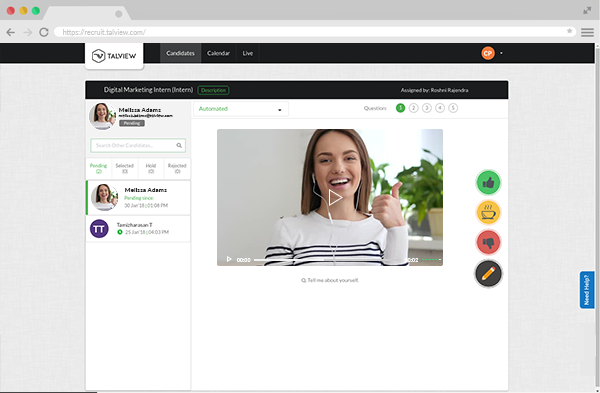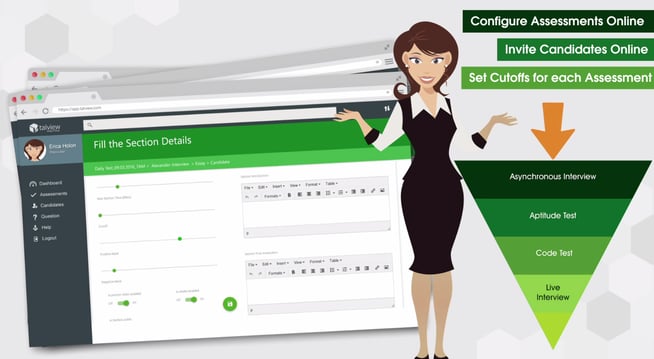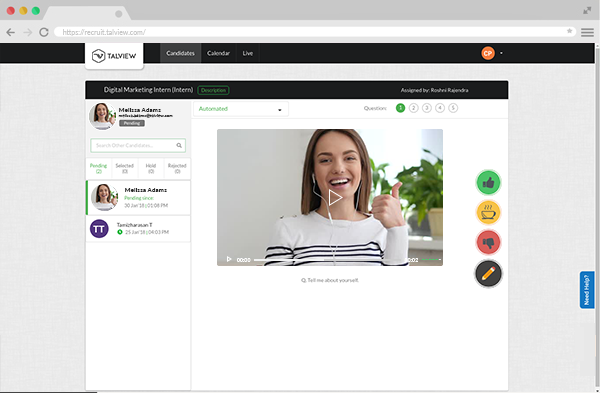Updated in November, 2020.
I founded Interview Master back in 2013 when video interviewing was still an emerging space. Today, it is mainstream, with all the leading organizations using it in one way or the other.
Whether you like it or not, you have to adopt video interviewing in your hiring process to stay competitive. The benefits it offers in terms of time to hire, quality of hire, and cost of hire can keep you well ahead of the curve.
This post aims at providing a comprehensive overview of the most critical aspects of video interviews based on my learnings over the past 6 years, helping many of the leading employers across 100+ countries to adopt and excel at video interviews.

This articles covers:
- What is Video Interviewing and its different types
- Pros and Cons of Buying a Video Interviewing Software
- Video Interviewing Software Providers
- How to Select the Right Video Interviewing Software for Your Organization
- Leading Organizations using Video Interviewing Software, and
- A Comparison of Video Interviews with Telephonic and Skype Interviews
We'll also cover the legal aspects of video interviewing and explore the latest developments in this space.
In case you’re new to this, let's go through a quick overview of what video interviewing is in the first place.
If you are familiar, skip to #2.
1. What is Video Interviewing?
A video interview is a job interview that is conducted remotely using video technology as its primary medium of communication. Video Interviewing or Video Recruiting or Digital Interviews is a fast emerging field in the landscape of recruitment today.
There are three major formats in which organizations conduct video interviews for recruitment:
i. Asynchronous Video Interviews or Recorded Interviews
This is an easy way to screen a high volume of candidates in one go. The employer defines a set of questions on an online recruiting software and invites a list of candidates to answer them
The questions are designed to elicit responses from the candidates that help the employer get a holistic perspective of the candidate, their skills, experience, soft skills, culture fit, etc.
Such an application is usually a cloud-based web application, like Gmail, where recruiters log in to create interview questions using video or text format. They can then send email invitations to candidates to attend the interview.
 A candidate attending a video interview on the Talview platform.
A candidate attending a video interview on the Talview platform.
By going to the link in the email invitation, candidates can attend the questions one by one. The application records the video or text response of the candidate through a webcam and a microphone.
So what happens after that?
The recruiter evaluates the recorded answers once the candidate submits them.
Typically, an in-person interview is 45 minutes long. A panel can evaluate up to 10-15 prospects at the same time with this technology!
Since responding to the questions and reviewing the responses can happen at different times, this form of interviewing is known as asynchronous interviewing. It is also called automated video interviewing.
ii. Live Interviews
Live Interviewing is another form of taking an online job interview. Instead of meeting the candidate in person, the employer conducts an online video meeting where they engage in a free-flowing discussion in real-time. It is used as a selection methodology in recruitment.
You might ask yourself -
Isn't this similar to any other video conferencing tool?
Not exactly. Video interviewing solutions are specifically made for the purpose of interviewing and offer additional functionalities and capabilities that help streamline recruitment.
In addition to having video calls, video interview software has other recruitment specific functionalities such as interview scheduling capabilities, AI-enabled behavioral insights, automated workflows, ATS integration, end-to-end encryption, embedded evaluation forms, etc.
For a detailed comparison between the two, read this blog post.
iii. Video Resumes
Video resumes are another screening methodology where the employer asks a candidate to submit a video introduction. The employer might give guidelines on what to talk about and how long the video should be.
But why do I want to listen to rehearsed answers?
This method is commonly used for roles where gauging a candidate’s communication skills and body language is critical to hospitality or acting.
Now that you understand what video interviewing is and its different methods available, let us look at the 12 most important aspects of video interviewing that one should know.
2. Benefits of Video Interviewing
The benefits of using a video interviewing platform, that most clients often cite are:

-
Reduced Time to Hire
Video interviews help you reduce time to hire by up to 50%. It does so by enabling recruiters and candidates to attend interviews from their home, saving commute time, and by allowing employers to record the video interview to share it with panel members to view and review without being present at the time of the interview.
Invite, schedule, hire - it's as simple as that!
-
Enhanced Candidate Experience
Video interviews enable candidates to attend online interviews across the globe, via web or mobile, at their convenience while providing a standardized, consistent experience.
-
Reduced Hiring Cost by 60%
Reduce the cost of hiring by up to 60%, by saving efforts spent on manual screening, coordination, logistics, or additional resources.
-
Better Employer Branding
Video interviewing tools allow branding of the platform with customizable banners, videos, color themes, and logos. This way, your organization will be perceived as tech-savvy and candidate-friendly.
-
Video Logs for Future References and Audits
All the videos are available for future reference. Much in the same way, evaluations and comments are also saved for audits in the future.
-
Modernization and Automation
Many video interviewing tools have advanced capabilities to analyze video interviews of candidates and generate their behavioral profiles, and recommend to you the most relevant set of candidates for the role.

A Talview Behavioral Insights report showing if the candidate has the required competencies for the role
-
Real-Time Reporting
Real-time reports are available to track panel bias, reduce turnaround time, etc. and overall improve the interviewing process.
-
Location No Bar with Remote Hiring
Since the interview is hosted over the internet, you can virtually hire candidates from across the globe — given the fact that they are either ready to relocate if they get selected or if they can work remotely with your company. This gives you access to a much wider talent pool and increases your probability to find the right talent.
Is that all?
No, a few more benefits are covered by Ben Karter in this blog post. Here is a bonus link on Video Interviewing Best Practices from Ere Media.
While video interviewing standardizes and streamlines recruitment, few of its drawbacks are:
- Video Interviewing requires candidates to use a laptop/PC or a smartphone. Not all candidates might have access to these devices.
- Live Interviewing requires reasonable internet speed, which is still a challenge in many countries
3. Online Video Interviewing Platforms vs Online Video Calling Tools?
While one can try to carry out different forms of video interviewing through plain vanilla video calling tools like Zoom, Skype, or Google Hangouts, these methods are not scalable and cannot provide the best results if used for recruitment.
What does that mean?
All standard online interviewing software tools have user roles for recruiters, hiring managers, and candidates. Each of them differ in the breadth of features and depth of capabilities.

For example, Talview provides detailed provisions to configure interview windows, candidate instructions, email notifications, evaluation forms, and more.
It also supports various other formats of online assessments like coding tests, psychometric analysis, objective tests, behavioral assessments, and essay tests.
There are also audio interviewing platforms available in the market today.
Advantages and Disadvantages of Using Skype or Zoom for Video Interviewing
The low-cost factor is the biggest advantage of video interviews, tempting several organizations to adopt Skype or Zoom as their means to a virtual interview.

Most companies need to reconsider what platforms they use as enterprise solutions for interviewing due to many critical deficiencies, such as:
- Skype doesn’t provide you with real-time support
- Connecting through a personal profile can seem intrusive and make the candidate feel uncomfortable.
- Many critical interview features like writing pads, recording, evaluation forms are missing.
- It cannot integrate it with your Applicant Tracking System.
- It doesn't have features to schedule and send invites/reminders to participants.
Check out this detailed comparison between Skype and video interviewing platforms.
A virtual interviewing or video interview software helps employers conduct various types of video interviews in a structured and scalable way.
4. Video Interview Software Providers
Some of the popular global video interviewing software providers are Talview, Hirevue, Sparkhire, Montage Talent, Hirevue, and Sonru.
Each of them varies in their features and capabilities. Detailed comparisons are available at the following links:
5. Video Interviewing Platform Pricing
Video Interviews are usually available in pay per interview, pay per job, user license, and enterprise license models. SMBs typically use the pay per interview/job model and it costs them typically around $10 per interview.
Larger organizations use user licenses and enterprise licenses.
For user licensed softwares, the client pays for the number of recruiter users using the platform. Panel user logins are provided free of cost. It costs around $500 to $1000 per month per user.
For enterprise licensed softwares, the client pays in proportion to the number of employees they have. The cost varies from $4 to $10 per employee per month based on the scale of the organization and the features opted for.
6. Leading Organizations Using Video Interview Solution

An evaluator's screen on Talview's assessment platform
Globally, many of the leading companies use video interviews for interviewing candidates.
Some of the companies who use video interviews in recruitment are Accenture, Federal Services, BASF, Best Mark, Caleres, Citizens Bank, Enterprise South Jordan, Geico, PSEG, Starbucks, Goldman Sachs, UNICEF, Teach First, Societe Generale.
Check out the success stories and testimonials of Talview's clients here.
Each industry uses video interviewing in different ways. In some sectors, online interviewing is used only for screening and there is at least one in-person discussion before the candidate is hired.
In other sectors video interviewing is coupled with online assessments like technical or aptitude tests. The staffing industry usually utilizes video interviewing to showcase potential hires to its clients.
Need more in-depth understanding? You can read through these detailed industry- specific guides put together by Talview below:
7. How to Select The Right Video Interviewing Software?
There are many tools in the market today, and it is easy to get confused about which tool would be the best fit for you. However, a majority of them are very basic and might not support a full-fledged use case.
Talview Video Interviewing is one of the pioneers in this space. It is a unifying platform that brings all your talent measurement and recruitment efforts to one place.

When selecting a video interviewing tool for yourself, you should keep in mind:
-
The Maturity of the Platform
The ability of a platform to handle various use cases like:
-
- Text, audio, and video questions
- Configurable waiting time for questions
- Configurable answer times
- Configurable registration forms
- Configurable pre and post-interview instructions
- Randomization of questions from a question bank
- Simple evaluation form builders and custom forms
- Multi-panel evaluation
- Elaborate notification management systems- email, SMS, IVR, scheduled reminders
- Configurable interview window
-
Mobile Support
iOS and Android support is imperative in today's world.
-
Integrations with Your Existing ATS
Talview can be integrated with Microsoft, SuccessFactors, Taleo, IBM Kenexa Brassring, Smartrecruiters, iCIMS, etc. Its ‘plug and play’ solution can be easily integrated with any ATS or assessment platform.
-
Branding Support
Candidate experience is of paramount importance. Standard branding practices involve private-labeled online pages where you can show prospects a welcome video and offer them information about the job and your company.
See some examples of the branding we have done for clients in the customer landing pages.
-
24x7 Hotline Support
You should also ensure that your online interview software provider is also extending 24*7 customer support for assistance.
We help our clients provide best in class support through multiple channels.
Candidates' feedback of video interviews has been very encouraging with almost 97% of them having a positive response.
We've written a whitepaper based on the survey among candidates on video interviews.
8. Why Is Video Interviewing Better Than Phone Interviews?
Video Interviews give a more holistic picture of the candidate. Hiring managers can make a much better judgment based on an audio-visual interaction compared to a simple telephonic interaction, where the candidate can easily engage in malpractices like impersonation, cheating, etc.
Some AI-based video interviewing services are also capable of analyzing the tone and body language of a candidate based on the audio and visual data points gathered from their video response to generate a behavioral insight report. These insights into a candidate's competencies help recruiters hire quality candidates faster.
Also, a record of the interaction, evaluation, etc can be maintained for a second opinion or future reference.
Here's a more detailed insight into why recruiters are replacing telephonic interviews for video interviews.
9. Are Video Interviews Legal?

According to the EEOC, under Title VII, it is not illegal for an employer to learn the race, gender or ethnicity of an individual prior to an interview. Of course, Title VII requires that all individuals be provided equal, non-discriminatory treatment throughout the hiring process.
If an employer observes a job seeker in a video clip, and either learns or surmises the person’s gender, race, or ethnicity, such knowledge could increase the risk of discrimination or the appearance of discrimination.
Employers need to ensure training the hiring officials and human resources staff about the appropriate responses when gender, race, or ethnicity are disclosed during recruitment.
Video clips might be analogized to information on a resume that clearly tells an individual’s race, such as, “President, Black Law Students Association.” In this situation, as with the video clip, the employer needs to focus on the person’s qualifications for the job.”
Summary of various legal opinions in this regard - becoming aware of such information through a video, even without the applicant affirmatively volunteering for it, should pose no bigger problem for an employer than information that is volunteered, or otherwise learned during an interview.
On a positive note, video interviewing assures that there will be a record of what was said during the interview process.
10. Candidate Feedback on Video Interview Experience
One important aspect of selecting a video interview software is candidate experience and feedback. We always collect feedback from candidates who use the Talview app about their experience. You can find the results of the same below.
It covers topics such as their overall feedback on the video interviewing experience, what candidates perceive as benefits of video interviewing for them and any other expectations they might have.

The feedback we received had more than 90% positive responses along with indications for improvement in some areas.
Isn't that awesome?
The recorded responses were based on the questions we asked after candidates attended the interview on the Talview platform.
11. Other Use Cases for Video Interviewing - Coaching
Coaching teams, especially sales teams, are the second most common users of video interviewing after hiring. Coaching videos are used to help new team members practice customer interactions and objection handling as much as they want.
Coaching is becoming a popular use case.
Best responses are also showcased for the benefit of the entire team as a part of video coaching. Such online HR interviewing coaches are considered one of the best ways to accelerate sales within the organization.
12. Future of Video Interviewing - Predictive Hiring
The future of video interviewing is already here. Talview launched Talview Behavioural Insights (also known as TBI)earlier this year, which builds a behavioral profile of a candidate based on the responses received during the video interview and is the first platform to do so.

TBI also uses extraction of key information from video interviews to build a relevance score for each candidate to a particular job description.
It is the world's first job competency measurement tool that uses psycholinguistics to create a behavioral profile of candidates. TBI categorizes skills according to every role into Critical, Essential, and Desirable and assesses candidates on the basis of those skills.
Conclusion
Video interviewing is a terrific tool for busy recruiters and hiring managers. It accomplishes almost everything an in-person interview can but with much greater time and location flexibility Along with many other features.
It also provides the ability to pass interviews around for group feedback instead of coordinating with multiple panelists to meet the candidate at the same given time.
On the one hand, you can give more candidates an opportunity to tell their story rather than just rejecting them based on resumes. On the other hand, you can save your precious time to select the real stars.
You've read the article, so now it's over to you.
Step 1: Tweet this article.
Step 2: Go and implement a video interview tool for your organization.



Leave a Reply